#Sagalassos
Explore tagged Tumblr posts
Text





1 Ocak'ta ikimiz de izinli olduğumuz için fırsat bu fırsat diyerek Bekir'le birlikte arabamızı Burdur, Bucak, Ağlasun yoluna sürdük. Görece tehlikeli virajlar ve engebeli yollar aştıktan sonra karşımıza daha önce görmediğimiz bizi karlı manzarasıyla büyüleyen Sagalassos Antik Kenti çıktı. Bu mevsimde gitmeyi düşünenler için birkaç önerim olacak:



Müzekartla QR kod oluşturarak girişteki turnikelerden geçiş yapabilirsiniz. Dijital müzekartınızı önceden hazırlayın.
Tuvalet kısmı var ancak tuvalette tabii ki su ve peçete yok. Hijyen malzemelerinizi kendiniz götürmelisiniz.
Diğer birçok antik kent liman ve ticaret merkezlerine kurulmuşken niçin Sagalassos'un dağın zirvesine kurulduğuna dair açıklamayı bence, tuvaletlerin olduğu kısma değil, girişte bir panoya asmak gerekir.
Biz bazı yerlerde dizimize gelen kar seviyesinde yürümeye çalışırken mini etekler, topuklu ayakkabılarla sosyal medyada gördüğü manzaranın birkaç fotoğrafını çekmek isteyen ve kayıp düşen bir sürü insan gördüm. Bot ya da çizme ile gelin.
Erken saatlerde gitmeye çalışın, daha sessiz ve daha sakin olduğu için doğayla daha çok içiçe geçtiğinizi hissediyorsunuz.
Güneş veya kar gözlüğü getirin.
Sıkı giyinmek önemli ama kat kat giyinmek daha önemli. Çünkü bölge itibariyle hem güneşin yakıcı etkisi hem de yüksek rakımdan dolayı rüzgarın sert etkisiyle bir sıcak bir soğuk durumu yaşıyorsunuz. Eldiven, bere şart.
Küçük bir işletme var ancak kış aylarında kapalıymış. Bu yüzden suyunuz, termosunuz, atıştırmalığınız neyse ihtiyacınız Ağlasun'dan önce yanınıza almanızda fayda var. Sagalassos'a varınca alacak yer bulamazsınız.
Araç park etmek sıkıntı, park yeri pek yok. Yol engebeli ve zorlayıcı üstelik gidiş dönüş olmasına rağmen tek şerit. Yavaş ve dikkatli gidin.
Yazdıklarım umarım faydalı olmuştur. Hem kar manzarası hem de antik kent manzarası bizi büyüledi açıkçası. Benim ilk kar deneyimimdi. Bu açıdan bir tık zordu. Çünkü daha önce gidip görmediğimiz bir yer olduğu için kar örtüsünün altında ne var bilemiyoruz. Bazı yerlerde kazı çalışmaları tamamlanmamış durumda. Dikkatli atın adımlarınızı ve keyfini çıkarın :)
5 notes
·
View notes
Text

..
#archaeology#history#autumn#october#academia aesthetic#sagalassos#travelling#türkiye#original photographers#burdur#travel#ancient greece#fall aesthetic#autumn vibes#sunset#architecture#ruins#turkey#türkei#autumn aesthetic#fall vibes#dark academia#antiquity#marble
19 notes
·
View notes
Text
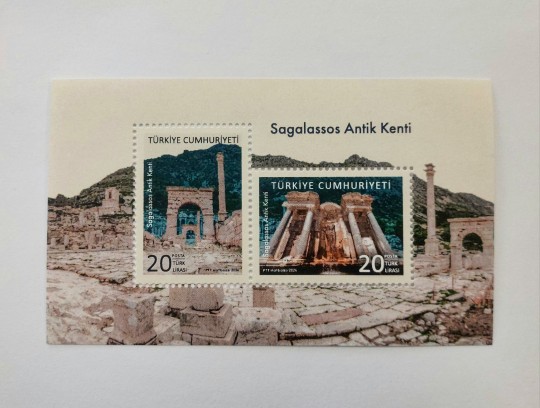

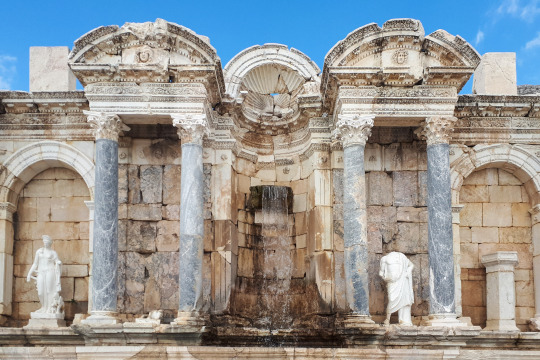
Sagalassos Antik Kenti anma pulları..
7 notes
·
View notes
Text
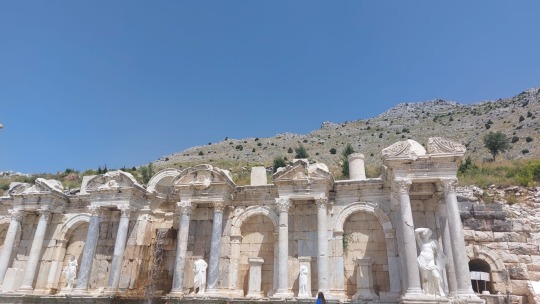
Ah İsabelle.
10 notes
·
View notes
Text
Antonina Fountain (Sagalassos), Burdur - Turkey
La Fuente Antonina (Sagalassos), Burdur - Turquía
La Fuente Antonina (Sagalassos), Burdur - Turquía
(English / Español / Italiano)
Antonina Fountain is a historical fountain located in the ancient city of Sagalassos in Ağlasun district of Burdur province, Turkey. Built during the reign of the Roman Emperor Marcus Aurelius between 161 and 180 A.D. and restored combining almost three thousand stones, it surpasses other fountains with its millenary water flowing for eighteen hundred years, whispering the history of antiquity to the ears!…. This cascading fountain is built to show the power and prestige of the Roman Empire to the world. Different coloured stones and precious Afyon marble brought from different parts of the empire were used in the fountain. The Antonine Fountain is also an indication of how rich and magnificent the Ancient City of Sagalassos was. The water of the fountain, which flows from the 4.5-metre high waterfall in the central niche, fills the 81 m³ capacity pool. There is also a legend about this fountain: according to the legend, the water of this fountain beautifies people and those who drink it fall in love!
The ancient city of Sagalassos was inscribed on the UNESCO Temporary World Heritage List in 2009.
-----------------------------------------------------------------------------
La Fuente Antonina es una fuente histórica ubicada en la antigua ciudad de Sagalassos en el distrito de Ağlasun de la provincia de Burdur, Turquía. Construida durante el reinado del emperador romano Marco Aurelio entre 161 y 180 d.C. y restaurada combinando casi tres mil piedras, supera a otras fuentes con su agua milenaria fluyendo durante mil ochocientos años, susurrando la historia de la antigüedad a los oídos!... Esta fuente con cascada está construida para mostrar el poder y el prestigio del Imperio Romano al mundo. En la fuente, se utilizaron piedras de diferentes colores y mármol precioso de Afyon traídas de diferentes partes del imperio. La Fuente Antonina también es un indicador de lo rica y magnífica que era la Ciudad Antigua de Sagalassos. El agua de la fuente, brota de la cascada de 4,5 metros de altura situada en el nicho central y llena la piscina de 81 m³ de capacidad. También hay una leyenda sobre esta fuente: según la leyenda, el agua de esta fuente embellece a la gente y ¡los que la beben se enamoran!
La ciudad antigua de Sagalassos fue incluida en la Lista Temporal del Patrimonio Mundial de la UNESCO en 2009.
-----------------------------------------------------------------------------
La Fontana Antonina è una fontana storica situata nell'antica città di Sagalassos, nel distretto di Ağlasun, nella provincia di Burdur, in Turchia. Costruita durante il regno dell'imperatore romano Marco Aurelio tra il 161 e il 180 d.C. e restaurata unendo quasi tremila pietre, supera le altre fontane con la sua acqua millenaria che scorre da settecento anni, sussurrando alle orecchie la storia dell'antichità!…. Questa fontana a cascata è stata costruita per mostrare al mondo il potere e il prestigio dell'Impero Romano. Per la fontana sono state utilizzate pietre di diversi colori e il prezioso marmo di Afyon, portato da diverse parti dell'impero. La Fontana Antonina è anche un'indicazione di quanto fosse ricca e magnifica l'antica città di Sagalassos. L'acqua della fontana, che sgorga dalla cascata alta 4,5 metri nella nicchia centrale, riempie la vasca di 81 m³. Esiste anche una leggenda su questa fontana: secondo la leggenda, l'acqua di questa fontana abbellisce le persone e chi la beve si innamora!
La ciudad antigua de Sagalassos fue incluida en la Lista Temporal del Patrimonio Mundial de la UNESCO en 2009.
video: @historiayarqueología
#ancient rome#roma antigua#antica roma#sagalassos#Emperor Marcus Aurelius#Marco Aurelio#s.II#2th century
4 notes
·
View notes
Photo

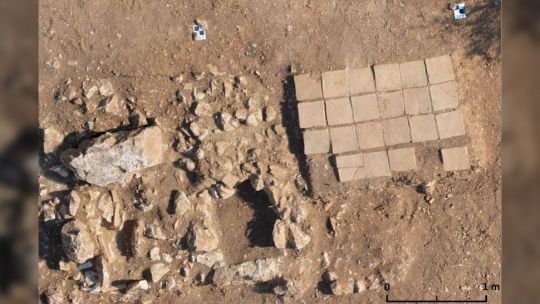
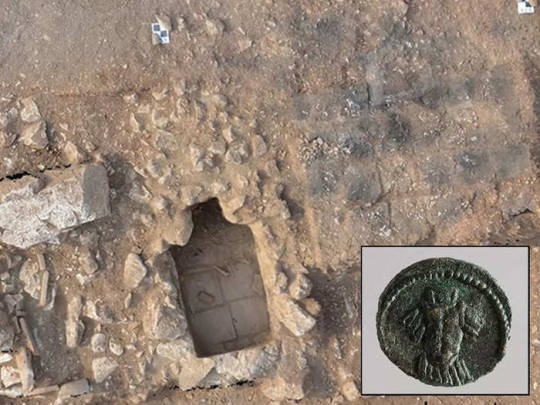
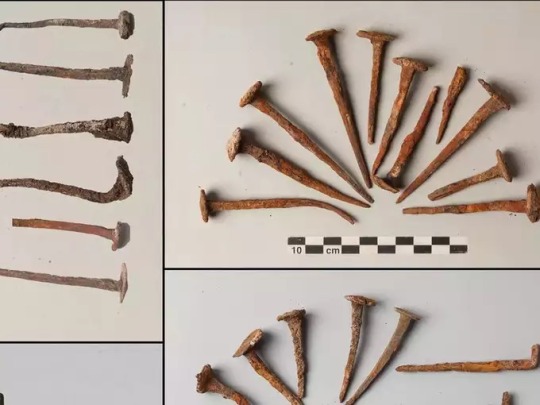
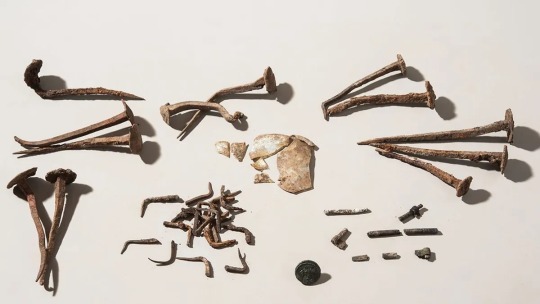
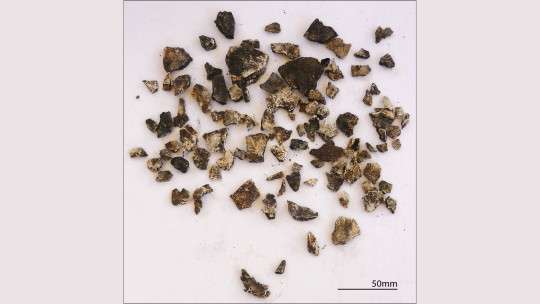
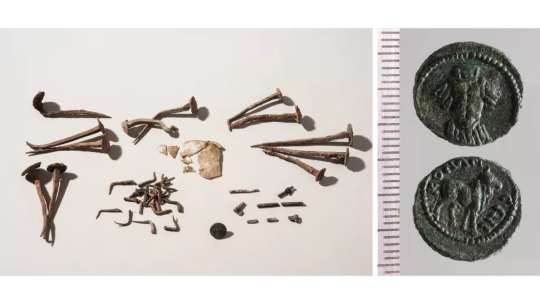
Roman-era Tomb Scattered with Magical 'Dead Nails' Found in Turkey
A 2,000-year-old tomb discovered in Turkey was sprinkled with "dead nails" and sealed off with bricks and plaster, likely to "shield the living from the dead."
In ancient Roman times, people may have feared the "restless dead," according to the discovery of a cremation tomb sprinkled with intentionally bent nails and sealed not only with two dozen bricks but also a layer of plaster, a new study finds.
The unusual grave, found at the site of Sagalassos in southwestern Turkey and dating to A.D. 100-150, had 41 bent and twisted nails scattered along the edges of its cremation pyre, 24 bricks that had been meticulously placed on the still-smoldering pyre, and a layer of lime plaster on top of that. The individual — an adult male — was cremated and buried in the same place, an unusual practice in Roman times, according to the study, published Feb. 21 in the journal Antiquity.
"The burial was closed off with not one, not two, but three different ways that can be understood as attempts to shield the living from the dead — or the other way around," study first author Johan Claeys), an archaeologist at Catholic University Leuven (KU Leuven) in Belgium, said in an email. Although each of these practices is known from Roman-era cemeteries — cremation in place, coverings of tiles or plaster, and the occasional bent nail — the combination of the three has not been seen before and implies a fear of the "restless dead," he said.
The archaeological site of Sagalassos was occupied from the fifth century B.C. to the 13th century A.D. and boasts numerous examples of Roman-era architecture, including a theater and a bath complex. Following its abandonment, vegetation quickly overgrew the city, preserving it.
As part of the Sagalassos Archaeological Research Project, burials in the outskirts of the town were excavated and studied, including the "non-normative cremation." Typically, Roman-era cremations involved a funeral pyre followed by the collection of the cremains, which were put in an urn and then buried in a grave or placed in a mausoleum. The Sagalassos cremation, however, was performed in place, which the researchers could tell from the anatomical positioning of the remaining bones.
Even more unusual was the contrast between the grave goods and the closure of the tomb. The archaeologists discovered typical funeral items — fragments of a woven basket, remains of food, a coin, and ceramic and glass vessels. "It seems clear that the deceased was buried with all appropriate aplomb," Claeys said. "It seems likely that was the suitable way of parting with a loved one at the time."
Marco Milella, a research fellow in the Institute of Forensic Medicine at the University of Bern in Switzerland who was not involved in this study, said in an email that "I tend to agree with their conclusion" about the bent nails, which Milella said are frequently found in Western European cemeteries dating to the first to second centuries A.D. "The sealing of the remains is also interesting and tantalizing given its possible association with the deposition of nails," Milella noted. "Fear of the dead is a possibility, as well as amulets to protect the dead — or both, perhaps."
Claeys thinks that the man in this strange cremation grave was likely buried by his next of kin in a ceremony that would have taken days to prepare and carry out. The set of beliefs that encouraged people at Sagalassos to bury this man in an unconventional way are best understood as a form of magic, or an act intended to have specific effects because of a supernatural connection. It is possible that his odd burial was made to counteract an unusual or unnatural death; however, the researchers found no evidence of trauma or disease on the bones. Unfortunately, even though the "magic cremation" overlaps in time with other graves, Claeys said that "it cannot be established with certainty whether or not any family members were buried nearby," as DNA is usually destroyed by high temperatures in ancient cremations.
"Regardless of whether the cause of [the man's] death was traumatic, mysterious or potentially the result of a contagious illness or punishment," the researchers concluded in the study, it appears to have left "the living fearful of the deceased's return."
By Kristina Killgrove.
#Roman-era Tomb Scattered with Magical 'Dead Nails' Found in Turkey#Sagalassos#ancient tomb#ancient gtrave#ancient artifacts#archeology#archeolgst#history#history news#ancient history#ancient culture#ancient civilizations#roman history#roman empire
34 notes
·
View notes
Text
Sagalassos antik kenti gezgin mevsimi
#sezer vatansever#gezgin mevsimi#Sagalassos#Burdur#antalya#mugla#Gezilcek yerler#camping#Travel#traveling#travel photography#Antik kent#sezervts
2 notes
·
View notes
Text

yedi renkli göl
büyüyünce gözyaşlarım
susuz havzalar kalmayacak
şimdi de kuraklığı süpürmeli
üstlerinin pislikleriyle tezat
belediyenin temizlik görevlileri
*
dolaş göllerin diyarını
suya kansın damağın
sagalassos’ta antoninler çeşmesi’nde
günahların damlıyor dudağının kenarından
göğüs boşluğunu hançerliyor her düşen
şeytanları yürüt kral yolundan
kuşak bağla yedi renkli göl’den
firari hançerini gizle
ürkütme kuraklığı
gözyaşlarım büyüyünce alacak öcümü
*
kazma vur yeni kuyulara
deniz seviyesine düştüğü vakit güneş
toprakla barıştır artık kazmayı
susuzluğunu dinle
kuyulara su vuruncaya kadar
gözyaşı şişelerini doldur
geçip gitsin yollarından krallar
*
yedi renkli gölden
savaşın kırmızısını alıp gitsinler
dullara karalar kalsın
askere çil çil altın sarısı bıraksınlar
düşman gözleyen buluta beyaz
göllere ve gözlere
mavili tüm tonlar kalsın
diğer renkleri dağıtın psidia halkları’na
büyüyünce gözyaşlarımı kral yapsınlar
göllerin diyarına
eylül iki bin on \ uşak
tevfik hatıpoğlu
3 notes
·
View notes
Text
Interesting. Local religious rights being combined with Roman?
12 notes
·
View notes
Video
youtube
Sagalassos (Greek: Σαγαλασσός) is an ancient city
0 notes
Text

..
#clouds#architecture#history#dark academia#archaeology#sagalassos#october#marble#original photographers#burdur#traveling#cloudy#antiquity#original photography#türkiye#ancient greece#academia aesthetic#soft colors#travelling#turkey#türkei#fall#autumn#fall aesthetic#autumn aesthetic#fall vibes#autumn vibes
15 notes
·
View notes
Text
#i like them both equally#but Apollo would be a nice nod to Sagalassos#because they found a bust of Apollo around the time I decided id adopt my kitten
2 notes
·
View notes
Text
Burdur Gezi Rehberi: Mutlaka Görmeniz Gereken En İyi 5 Mekan
Burdur, ülkemizin en güzel doğal güzelliklerini içinde barındıran şehirlerimizden biri. İşte Burdur’da mutlaka gezilmesi gereken en iyi 5 mekan ile karşınızdayız. Burdur, şüphesiz ülkemizin en güzel doğal güzelliklerine ev sahipliği yapan şehirlerinden biri. Belki de birçok insanın bilmediği, Burdur’da mutlaka gezilmesi gereken bu 5 mekan, Burdur’u ziyaret etmeniz açısından en iyi nedenlerden…
#akdeniz gezileri#burdur ceviz ezmesi#burdur gölü#burdur gezi rehberi#burdur müzesi#burdur yemekleri#burdur şiş#doğa turizmi#göller bölgesi#kültür turizmi#sagalassos antik kenti#salda gölü#türkiye gezi rotaları
0 notes

























